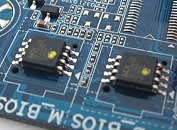Tuesday, June 16th 2009

DualBIOS Becomes Standard Feature for All Gigabyte Motherboards
Gigabyte decided to make its DualBIOS feature standard for all its motherboards. The feature involves using two BIOS EEPROM chips to store two copies of the BIOS. In the event of a failure of the first copy, the system starts with the second copy of the BIOS, and attempts to replace the first copy. The feature is especially useful when the BIOS is damaged in the process of updating it, or physical damage to the ROM chip. Gigabyte initially made this feature exclusive for its higher-end motherboards, and propagated it lower along the lineup.
Sources:
DigiTimes, HardwareZone

28 Comments on DualBIOS Becomes Standard Feature for All Gigabyte Motherboards
Great feature, never kicked in on the ones i used( flashes worked fine) but i dont mind flashing any kind of bios anymore.
should really be a standard for ALL m/b makers.
my next board is gonna be a giga
I always liked them better
This is excellent news.
My GA-EP45-UD3P has a dual BIOS and was one of the reasons why I bought it over the competition. The extra copper and fantastically tweakable BIOS were some of the other reasons.
Seriously though, maybe the higher end ones will now have 3 lol
I've had Dual-bios Gigabyte boards for YEARS and its never made any difference to me at all... I've never seen any advantage what-so-ever.
I've also never seen any disadvantage - It's just never made any difference to any bard I've ever fitted.
Come to think of it - of the many Gigabyte boards I've fitted over the years I've never had a bios failure - even on the single bios ones.
Socketed or not? well Geez, if you manage to crap out 2 BIOS chips then you either need to go back to hacker school, or get a new MoBo - having sockets wont help you either way.